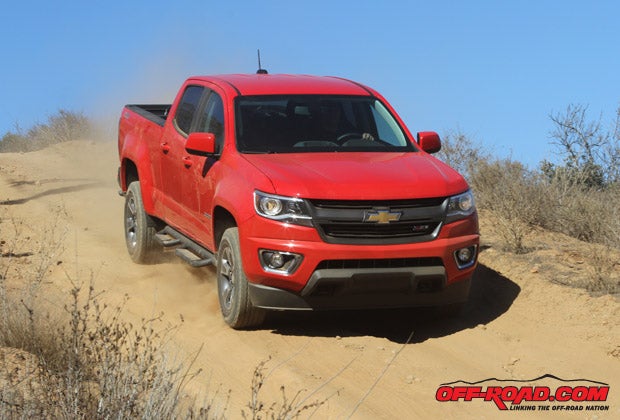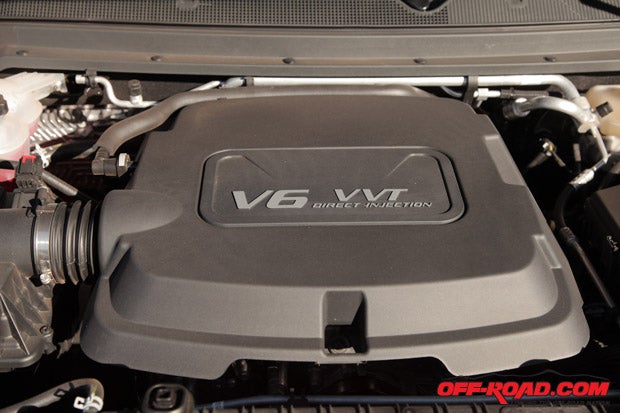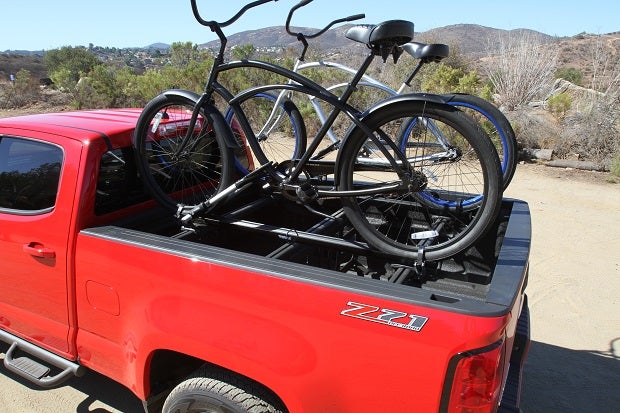First Drive: 2015 Chevy Colorado & GMC Canyon Cont.
GM did a great deal of research on the mid-sized market over the past few years, and one of the biggest complaints it found is that most of the trucks in the class are plagued by a noisy ride. Thus, interior noise reduction was a key goal for GM, which looked to its half-ton trucks for solutions that would benefit the Colorado and Canyon. Among them are triple-sealed, inlaid doors that help quiet road and wind noise. Fibrous wheelhouse liners also aid in reducing road noise, as does a liquid-applied sound deadener. GM also laid under-floor acoustic absorber in the cabin to further reduce powertrain and road noise.
Impressions
GM invited us to Del Mar, California, to get behind the wheel of both trucks. To show itís not afraid of the competition, GM even brought along a Tacoma and a Frontier for comparisonís sake. There was a variety of configurations of both the Chevy and the GMC available to sample, and we had free reign to drive the trucks around town.

Right off the bat we noticed that both the two trucks possess clearly unique front-end styling. The GMC Canyon has a square front end, with square LED signature headlights and a large chrome grille that signifies it as a GMC truck. The Colorado, however, is much sportier looking, with a smaller black grille and angled headlights. While both trucks share the same basic dash design, the GMC features a soft-touch material with stitched seams and premium surfaces for the interior to give it a more luxurious feel.
Both the Colorado and Canyon share the same 8-inch touchscreen that sits dead center in the newly designed front dash. Overall, this might be one of the best features of the platform, as the layout is not only pleasing to the eyes but also very easy to use. Aside from being the largest offered in the segment, its touchscreen interface and radio controls are easy to locate even while driving, and they are clearly segregated from the A/C controls that sit just a little lower on the center stack. The design of this center stack is a highlight on the Colorado and Canyon and really gives the truck a great first impression upon entryóitís clearly where your eyes are drawn.
GM says the newly designed Colorado/Canyon seats offer as much as 3 more inches of leg room over the competition, and in our opinion they are comfortable and roomy enough for 6í0Ē tall drivers and passengers up front. However, the backseat is pretty snug in the Extended Cab, although itís much roomier in the Crew Cab. The driverís seat offers electric and manual adjustability for up-and-down and front-to- back adjustments.
We got behind the wheel of a 3.6-liter V6 first, taking it on city streets, and hitting some of the areaís winding roads before jumping on the freeway for an uphill and downhill impression. The six-speed transmission shifts smoothly, albeit a bit earlier than weíd expect on a truck Ė then again, thatís where the fuel economy comes in. The V6 offers plenty of power, and it stays strong during on steep hill climbs at freeway speeds. We even pulled a 2000-plus-pound trailer loaded with two personal watercraft and were impressed with the V6ís towing power.

After spending some time in the V6 Canyon and Colorados, we hopped into a similar Toyota Tacoma V6. On paper, the numbers comparison of these two trucks is interesting, as the 4.0-liter V6 on the Tacoma is rated at 236 hp and 266 lb.-ft. of torque, whereas the a 3.6-liter V6 on the Colorado and Canyon is rated at 305 hp and 269 lb.-ft. of torque. The GM V6 has only a slight advantage in torque and a more noteworthy advantage in horsepower, yet we canít say that we felt a huge difference between the two. Truth be told, after hearing the 305 hp figure we expected the GM V6 to be a little peppier than it is. Itís not that the engine is really lacking, but a little bigger shove in the seat would be nice.
Where the Colorado and Canyon clearly have an advantage is in fuel economy: A 2WD V6 Tacoma gets 17 mpg city/21 mpg highway while the 2WD Colorado/Canyon V6 gets 18/26. The 2WD version gets a combined 21 mpg and the 4WD a combined 20 mpg. No doubt, the Colorado/Canyonís six-speed transmission aids its fuel economy, but low-end punch is clearly sacrificed.
We drove the 2.5-liter inline four-cylinder motor and thought it felt quite good, but the power hungry fiends in us preferred the V6. Rated at 200 hp and 191 lb.-ft. of torque, the four banger offers only a slight improvement in fuel economy when compared to the V6 (20 mpg city/27 mpg highway), and it really doesnít save the buyer a lot of money at the point of purchase. Moving up to the V6 at any trim level only costs an additional $1,220 ($995 on the Z71), and frankly we canít see enough savings in fuel costs to justify choosing the four-cylinder.
The Colorado/Canyon chassis handles great. Its steering is tight and controlled, and the turning radius is exactly what youíd expect in a mid-sized truck (even a mid-sized truck that isnít exactly small). Visibility is good in both the Extended Cab and Crew Cab options, and the backup camera makes parking and back-up scenarios much simpler.
Notable features found on the Colorado and Canyon (which are unique to the class) include Lane Departure Warning to inform the driver when they drift from their lane, and Forward Collision alert informs you when a potential front-end accident could occur due to slowing traffic or something of the sort.
We also drove our Canyon/Colorado sample units in the dirt, and although we didnít really get to do any serious off-roading, we did get a basic feel for how the platform handles bumps and weathered uphill and downhill sections. The twin-tube shocks soak up the bumps well enough, and the electronically engaged four-wheel-drive system is easily controlled via a knob just to the left of the steering wheel. The great news for those getting off the pavement is that the air dam located below of the front bumper Ė one GM representative said the air dam provides as much as a 1 mpg improvement Ė is removable to increase ground clearance.

Obviously aimed toward the off-road crowd, the Z71 package includes slightly more aggressive Goodyear all-terrain tires, the automatic locking rear differential as standard equipment (itís optional on the WT and LT) and a transfer-case skid plate Ė but thatís about it. The Z71 is really more of a trim level than an off-road package, and some off-road enthusiasts might find that disappointing. The automatic locking rear differential does provide added traction if traction to one of the rear wheels is lost, but we would still prefer the option to control the locker manually. When in the dirt, we had to remember to turn off traction control as well, as it intervenes so much that it actually makes driving in loose dirt more of a challenge.
We really like the GearOn storage system, which provides a thoughtful option for hauling larger items without losing the storage of the truck bed itself. To provide added value, the damped tailgate is also a nice feature not offered on any other trucks in the segment. The CornerStep rear bumper is handy because it makes entering and exiting the truck bed an easier task.
Final Thoughts
Whether the Colorado and Canyon will actually redefine the mid-sized truck segment remains to be seen, but weíre impressed with the platform and feel that it does improve upon whatís currently offered. That said, it isnít perfect, and the hard-core off-road enthusiast will arguably feel let down by the lack of true off-road features on the Z71 package.
Another big thing for potential buyers of the Colorado/Canyon to consider is that a 2.8-liter Duramax diesel-powered version is coming down the pipeline for 2016. We imagine this diesel will have even better fuel economy figures for the class, and a diesel-powered mid-sized truck would certainly be groundbreaking since no truck maker has brought one to the U.S. despite their popularity in the global market.
But even if GM stuck with just the gasoline version, weíd still like the new Colorado and Canyon. Although we canít help but wonder what these trucks will feel like with a small diesel motor, we did enjoy the V6-powered versions, and we look forward to doing a more in-depth review soon.


 Your Privacy Choices
Your Privacy Choices